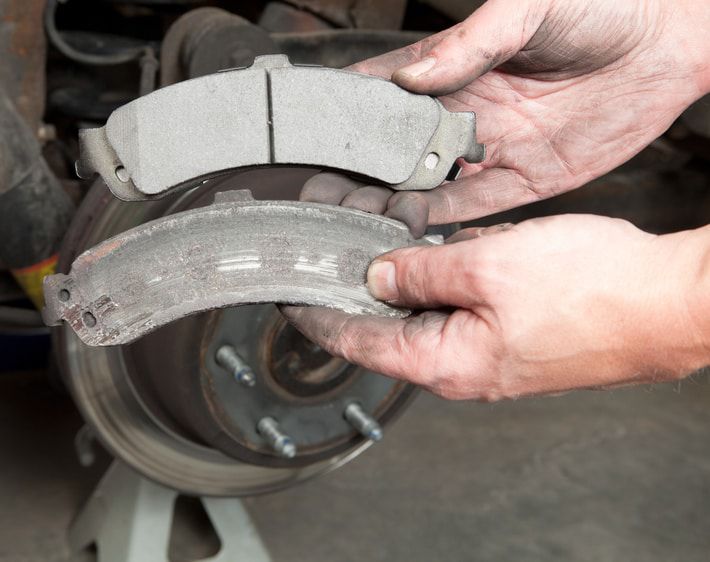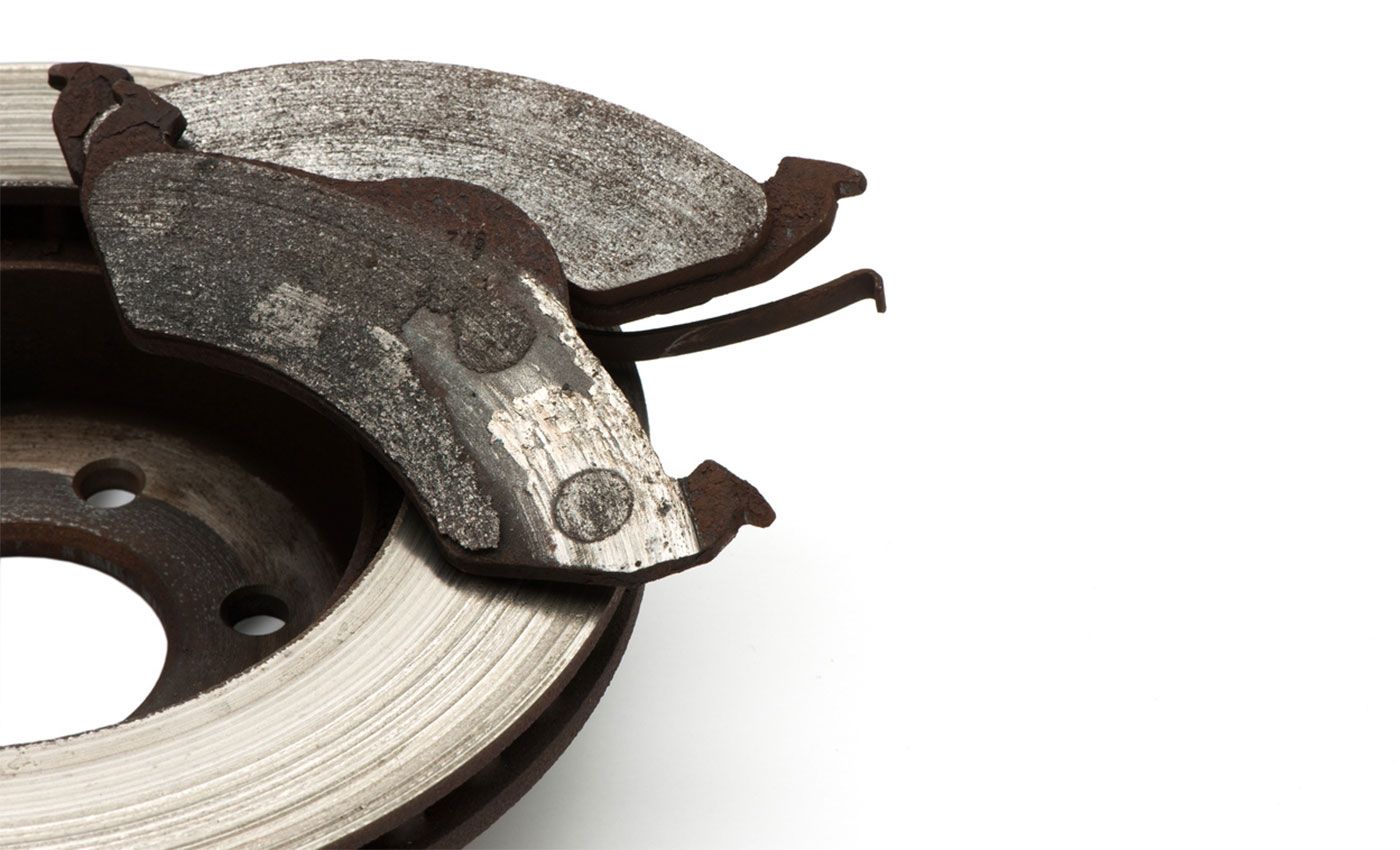Key Takeaways
- Driving with worn brakes can damage other components like brake rotors and calipers, leading to more expensive repairs due to metal-on-metal grinding.
- Worn brakes can significantly increase stopping distances, making it harder to stop your vehicle quickly and safely.
- Excessively worn brake pads can cause your car to vibrate when braking and lead to uneven tire wear.
- Regular brake inspections and timely replacements of brake pads are crucial for maintaining brake system efficiency and overall vehicle safety.
There are better ways to announce your arrival than squealing and squeaking brakes. But embarrassment isn’t the only reason to avoid driving with worn-out brake pads. If you’re wondering, “Can I drive with worn brake pads,” you should know that doing so can place you and your passengers, other drivers, and your vehicle at risk of harm.
We’ll break down (get it?) what can happen to your vehicle when you drive with worn brakes, the risks of driving with worn brakes, how brakes become worn, and the signs it might be time to schedule a brake service.
The Risks of Driving With Worn Brakes
1. Damage to Brake Rotors and Calipers
Brake pads are the first line of defense in your braking system. Once they’re worn, the exposed metal grinds against the rotors, leading to damage that’s much more costly to repair. Additionally, excessive heat from metal-on-metal contact can warp or crack your rotors. Don’t let a $100 fix turn into a $1,000 repair job!
Getting your brake pads changed, and your brake system inspected regularly can help you get the most life out of all its parts and avoid expensive and preventable brake repairs.
2. Longer Stopping Distances
The more worn down your brakes become, the harder it can be for them to slow and stop your vehicle (depending on how the pad wears). If you're driving with worn brakes that are glazed, it may feel like you have to push the brake pedal down harder to bring it to a halt. Imagine needing to slam the brakes in an emergency and realizing your car takes twice as long to stop. That’s the danger of worn brake pads—your reaction time may not be enough to prevent a collision.
Vibrations While Braking
Uneven wear or damaged rotors can cause vibrations throughout your car and steering wheel. This isn’t just uncomfortable; it’s a clear sign that your braking system is compromised, and there's a good chance it's time to have your brakes serviced.
Uneven Tire Wear
When you drive with worn-out brake pads, rotors, or calipers, you may find yourself slamming on the brake pedal more often to slow or stop the car. Frequent hard or inconsistent braking can wear your tires down quicker or cause them to become unbalanced, leading to uneven tire wear. Thus, reducing your tires' lifespan and compromising your vehicle’s handling.
In short, protect your tires by maintaining your brakes.
How Do Brakes Become Worn?
Your car’s braking system is a workhorse designed to handle thousands of stops over its lifetime. But like any hardworking component, your brake system will experience wear and tear over use and time. Brakes become worn due to several factors:
Driving Habits
Frequent hard braking, especially in stop-and-go traffic, accelerates brake pad wear. Think of it like overworking your muscles—constant strain takes its toll quickly!
Brake Pad Material Matters, Too
Organic brake pads may be easier on your wallet initially, but they wear out faster than semi-metallic or ceramic pads, potentially costing more in the long run.
Mileage & Use
Brakes typically last between 25,000 and 70,000 miles. The heavier your driving load, the faster they’ll need replacement.
Environmental Conditions
Hilly terrains and frequent downhill drives mean extra work for your brakes, leading to quicker wear and tear.
Signs Your Brakes Are Wearing Out (Or Are Already Worn Out)
Your brakes don’t wear out overnight. Over time, they’ll send out warning signals. Watch for these signs of worn brakes:
- Squeaking or Squealing Noises: Annoying? Yes. A clear sign your brake pads are crying for help? Absolutely!
- Grinding Sound: This harsh noise could mean your pads are completely worn, and metal-on-metal contact is damaging the rotors. Hearing grinding when you brake means it’s time for a brake inspection as soon as possible.
- Dragging or Slow Response Time: Suddenly, stopping your car feels harder and harder. Your brakes may be dragging, or stops are taking longer than usual. If your stopping process feels like you’re on ice, take it as a sign that your brakes might need prompt attention.
- Vibrations When Braking: Notice your steering wheel shaking? That’s your car telling you it’s time to get your brake system inspected.
Can You Drive With Worn Brake Pads?
So, can you drive with worn brake pads? Technically, yes. Should you? Absolutely not — especially if they are excessively or unevenly worn. Every time you press the brake pedal, you’re gambling with your safety and the health of your car’s braking system. Worn pads increase stopping distance, strain other crucial brake components, and make your car prone to overheating brakes — a recipe for disaster.
Driving with worn brake pads also amplifies unpleasant sounds, like squealing or grinding, making your daily commute an auditory nightmare.
Is It Dangerous to Drive With Worn Brake Pads?
Yes, it is extremely dangerous to drive with worn brake pads. Here’s why:
- Reduced Stopping Power: Your ability to stop quickly in emergencies diminishes, increasing the likelihood of accidents.
- Increased Risk of Brake Failure: Overheated brake fluid from constant friction can lead to brake fade or total brake failure, leaving you powerless to stop.
- Damage to Critical Components: Prolonged metal-on-metal grinding can warp or crack rotors, and even damage calipers, turning a simple brake service into a costly overhaul.
- Compromised Safety in Adverse Conditions: Slippery roads are already challenging. Worn brakes only worsen the risk, making safe stops a near-impossible task.
If your brake pads are worn, head to Firestone Complete Auto Care as soon as possible.
Caring for Car Brakes: 4 Preventative Measures to Help Avoid Worn Brakes
Routine Brake Inspections
Schedule a brake check every 6-12 months or as recommended by your vehicle’s manufacturer. An inspection can catch issues before they become costly repairs.
Replace Brake Pads Promptly
Don’t wait for the screeching sound—it’s a last-resort warning. Preventative maintenance saves money and keeps you safe. Head to a reliable, trusted technician at Firestone Complete Auto Care instead of attempting to replace your brake pads at home.
Adjust Driving Habits
Gentle braking and anticipating stops can significantly extend the life of your pads and rotors. Drive smarter, not harder!
Keep Brake Fluid in Check
Low or dirty brake fluid can reduce braking efficiency and accelerate wear. Brake fluid, like engine oil, needs to be replaced at certain mileage intervals and should be checked or replaced according to the manufacturer's suggested maintenance schedule.
Don’t Drive With Worn Brakes – Turn to the Pros at Firestone Complete Auto Care
Your brakes are critical to your safety, and ignoring their warning signs can lead to more expensive repairs and unsafe driving conditions down the road. If it’s been a while since your last brake service, visit your nearest Firestone Complete Auto Care. Our expert technicians will ensure your braking system is in top shape, so you can drive with confidence and peace of mind. Schedule a brake inspection today to keep your vehicle running – and stopping – as it should.


